#l'historie
Text






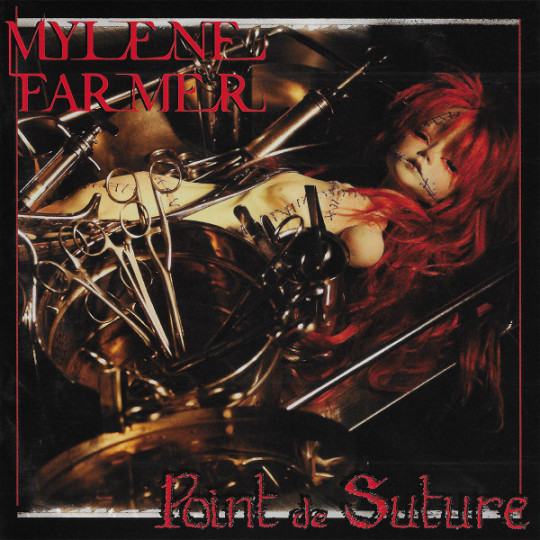


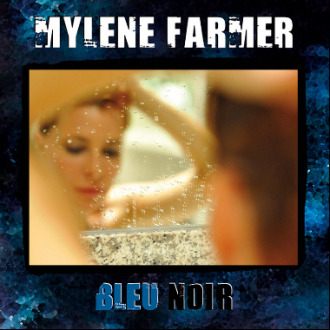
there is something really comforting to me about late aughts early teens Mylène and this very specific aesthetic she had going
#mylène farmer#point de suture#bleu noir#lonely lisa#dégénération#ouis mas... non#l'historie d'une fée c'est
3 notes
·
View notes
Text
Today's queer manga doesn't have an official English translation so I'm giving you the German title:
There is no future in this love, by Morihashi Bingo

Original title: Kono Koi ni Mirai wa nai / この恋に未来はない
Genres: Drama, Romance, Slice of Life
Themes: Love, Homosexuality, Society, Trans Identity, Secrets
Japanese volumes: 2 (Finished)
Tokyo, 1980's. Yuji Manase is a student. However, he hides two secrets he has never told to anyone: the first is his feelings towards his long-time friend Masaki Matsunaga, the other is the discomfort he feels towards his body. One day, Yuji holds a dress his sister left at his appartment, not knowing this action would change his life...
This one is short but packs a punch. Even though the story focuses on Yuji, we meet all these different people who all have their own struggles (family, love, money, sexuality...) and they mix together to paint a touching portrait.
The moment when Yuji finds out that there are other people like her* and that there's a place she can be her true self and be safe made me very emotional, it's a beautiful moment.
Anyways, it's a beautiful story but I wasn't able to find an official English version, which is a shame. You can still find it online of course, but you can't buy it to support the creator... unless you speak Japanese, French or German.
*I'm using she/her here because Yuji is a trans woman. The summary uses he/him because this is something she realises during the story.
Note: As this series is a bit more "serious" and focused on queer identities and strugles, I feel like I should probably give some content warning so you can avoid getting triggered if that's something you're scared of. Take care of yourself 🌈
Content Warning: gender dysphoria, blood and self harm. Also, this is about a trans woman who decides to keep living as a man for the sake of her own safety, if it's not something you want to read, then don't.
French version under the cut
Titre VF : Celle que je suis
Titre original : Kono Koi ni Mirai wa nai / この恋に未来はない
Genres : Drame, Romance, Slice of Life
Thèmes : Amour, Homosexualité, Société, Transidentité, Secrets
Volumes VO : 2 (Terminé)
Années 80, Tokyo. Yûji Manase est étudiant. Mais il vit au quotidien avec deux secrets qu'il n'a jamais révélé à personne : d'une part, les sentiments qu'il éprouve pour son ami de longue date Masaki Matsunaga, et de l'autre, le malaise qu'il ressent vis-à-vis de son corps. Un jour, Yûji pose la main sur une robe que sa sœur a laissée dans son appartement, sans savoir que cet acte allait bouleverser sa vie...
Celui-là est court mais costaud. Même si l'historie se concentre sur Yuji, on rencontre toutes ces personnes qui ont chacune leurs propres problèmes (famille, amour, argent, sexualité...) et elles se mélangent pour peindre un portrait touchant.
Le moment où Yuji réalise qu'il existe d'autres personnes comme elle*, un endroit où elle peut être elle-même en toute sécurité m'a vraiment ému, c'était un moment très beau.
Bref, c'est une jolie histoire.
*j'utilise elle ici parce que Yuji est une femme trans. Le résumé utilise il parce que c'est quelque chose dont elle se rend compte au cours de l'histoire.
Note: Comme cette série est un peu plus "sérieuse" et se concentre sur les identités et problèmes de la communauté queer, je pense que c'est mieux si je donne une liste de content warning pour éviter de réveiller des traumatismes chez certain.es. Prenez soin de vous 🌈
Content Warning : dysphorie de genre, sang et automutilation. Aussi, cette histoire est à propos d'une femme trans qui décide de continuer de vivre en tant qu'homme pour sa propre sécurité, si c'est quelque chose que vous ne voulez pas lire, ne le faites pas.
#there is no future in this love#kono koi ni mirai wa nai#celle que je suis#morihashi bingo#manga#manga recommendation#manga recs#books#book recs#queer manga#happy pride 🌈
13 notes
·
View notes
Photo


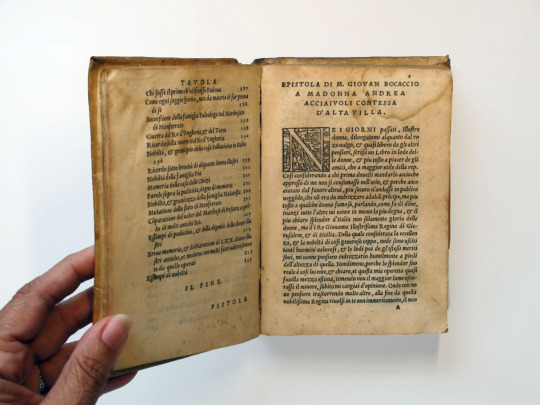


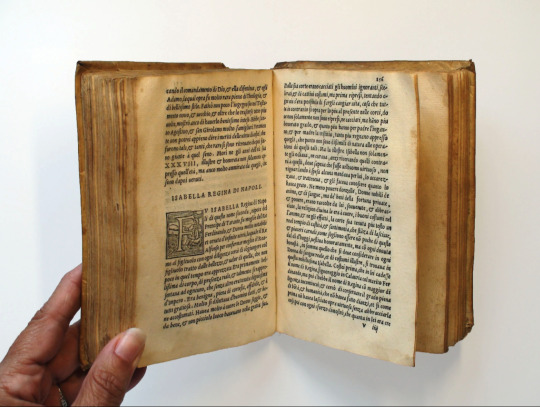
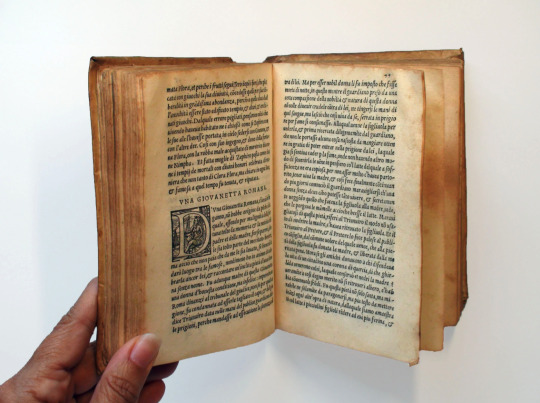
BUY IT NOW
Libro Di M. Gio Boccaccio Delle Donne Illustri
Tradotto Per Messer Giuseppe Betussi.
Con Una Additione Fatta,
Dal Medesimo Delle Donne Famose Dal Tipo Di M. Giovanni Fino à I Giorni Nostri
& Alcune Altre State Per Inanzi,
Con La Vita Del Boccaccio, & La Tavola Di Tutte L'historie, & Cose Principali
Che Nell'opra Si Contengono.
All'illustriss. S. Camilla Pallauicina Marchese Di Corte Maggiore.
In Vineggia M D LVIII
RARE, ITALIAN LANGUAGE
ILLUSTRATED
Publisher: Francesco e gli Imperatori, Veneggia (Venice)
Copyright: 1558
--ABOUT THIS ITEM--
Item Dimensions: 6.0 inches x 4.5 inches
Boccaccio's On Famous Women (De claris mulieribus) is a remarkable work that contains the lives of one hundred and six women in myth and history, ranging from Eve to Boccaccio's contemporary, Queen Giovanna I of Naples. It is the first collection of women's biographies ever written. Boccaccio composed it at Certaldo in 1361-62 and revised it in various stages to the end of his life in 1375. He dedicated it to Andrea Acciaiuoli, countess of Altavilla in the kingdom of Naples and sister of Niccolò Acciaiuoli, the grand seneschal of Queen Giovanna I.
In his preface, the author states that the biographies of illustrious men had been written often by a number of excellent writers, and he cited his hero Petrarch's Lives of Famous Men (De viris illustribus) as an example. No one, however, had ever done the same for women. Boccaccio, therefore, presents a wide variety of women from antiquity to his own time, offering their lives as both moral exemplar and entertaining reading. On Famous Women is the earliest source of women's biography in the West and has had a long and distinguished publication career and literary influence.
The famous women included are:
1. Eve, the first woman in the Bible
2. Semiramis, queen of the Assyrians
3. Opis, wife of Saturn
4. Juno, goddess of the Kingdoms
5. Ceres, goddess of the harvest and queen of Sicily
6. Minerva
7. Venus, queen of Cyprus
8. Isis, queen, and goddess of Egypt
9. Europa, queen of Crete
10. Libya, queen of Libya
11 and 12. Marpesia and Lampedo, queens of the Amazons
13. Thisbe, a Babylonian maiden
14. Hypermnestra, queen of the Argives and priestess of Juno
15. Niobe, queen of Thebes
16. Hypsipyle, queen of Lemnos
17. Medea, queen of Colchis
18. Arachne of Colophon
19 and 20. Orithyia and Antiope, queens of the Amazons
21. Erythraea or Heriphile, a Sibyl
22. Medusa, daughter of Phorcus
23. Iole, daughter of the king of the Aetolians
24. Deianira, wife of Hercules
25. Jocasta, queen of Thebes
26. Almathea or Deiphebe, a Sibyl
27. Nicostrata, or Carmenta, daughter of King Ionius
28. Procris, wife of Cephalus
29. Argia, wife of Polynices and daughter of King Adrastus
30. Manto, daughter of Tiresias
31. The wives of the Minyans
32. Penthesilea, queen of the Amazons
33. Polyxena, daughter of King Priam
34. Hecuba, queen of the Trojans
35. Cassandra, daughter of King Priam of Troy
36. Clytemnestra, queen of Mycenae
37. Helen of Troy, whose abduction by Paris began the Trojan War
38. Circe, daughter of the Sun
39. Camilla, queen of the Volscians
40. Penelope, wife of Ulysses
41. Lavinia, queen of Laurentum
42. Dido, or Elissa, queen of Carthage
43. Nicaula, queen of Ethiopia
44. Pamphile, daughter of Platea
45. Rhea Ilia, a Vestal Virgin
46. Gaia Cyrilla (Tanaquil), wife of King Tarquinius Priscus
47. Sappho, woman of Lesbos and poet
48. Lucretia, wife of Collatinus
49. Tamyris, queen of Scythia
50. Leaena, a courtesan
51. Athaliah, queen of Jerusalem
52. Cloelia, a Roman maiden
53. Hippo, a Greek woman
54. Megullia Dotata
55. Veturia, a Roman matron
56. Thamyris, daughter of Micon
57. Artemisia, queen of Caria
58. Verginia, virgin and daughter of Virginius
59. Eirene, daughter of Cratinus
60. Leontium
61. Olympias, queen of Macedonia
62. Claudia, a Vestal Virgin
63. Virginia, wife of Lucius Volumnius
64. Flora, goddess of flowers and wife of Zephyrus
65. A young Roman woman
66. Marcia, daughter of Varro
67. Sulpicia, wife of Quintus Fulvius Flaccus
68. Harmonia, daughter of Gelon, son of Hiero II of Syracuse
69. Busa of Canosa di Puglia
70. Sophonisba, queen of Numidia
71. Theoxena, daughter of Prince Herodicus
72. Berenice, queen of Cappadocia
73. The Wife of Orgiagon the Galatian
74. Tertia Aemilia, wife of the elder Africanus
75. Dripetrua, queen of Laodice
76. Sempronia, daughter of Gracchus
77. Claudia Quinta, a Roman woman
78. Hypsicratea, Queen of Pontus
79. Sempronia, a Roman Woman
80. The Wives of the Cimbrians
81. Julia, daughter of the dictator Julius Caesar
82. Portia, daughter of Cato Uticensis
83. Curia, wife of Quintus Lucretius
84. Hortensia, daughter of Quintus Hortensius
85. Sulpicia, wife of Cruscellio
86. Cornificia, a poet
87. Mariamme, queen of Judaea
88. Cleopatra, queen of Egypt
89. Antonia, daughter of Antony
90. Agrippina, wife of Germanicus
91. Paulina, a Roman woman
92. Agrippina, mother of the Emperor Nero
93. Epicharis, a freedwoman
94. Pompeia Paulina, wife of Seneca
95. Poppaea Sabina, wife of Nero
96. Triaria, wife of Lucius Vitellius
97. Proba, wife of Adelphus
98. Faustina Augusta
99. Symiamira, woman of Emesa
100. Zenobia, queen of Palmyra
101. Joan, an Englishwoman, and Pope
102. Irene, Empress of Constantinople
103. Gualdrada, a Florentine maiden
104. Constance, Empress of Rome and queen of Sicily
105. Camiola, a Sienese widow
106. Joanna, queen of Jerusalem and Sicily
#Camiola#Gualdrada#Zenobia#Empress Irene#Pompeia#Epicharis#Triaria#Cornificia#Claudia Quinta#Sophonisba#Berenice#Joanna of Jerusalem#Agrippina#Hypsicratea#Sempronia#Dripetrua#Curia#Paulina#Cleopatra#Cloelia#Circe#Tertia Aemilia#Theoxena#Boccaccio#giovanni boccaccio#On Famous Women#antiquarianbooks#antiquarian books#book#books
7 notes
·
View notes
Text

C'est l'historie de la famille, ce fardeau. Ça commence, robe rouge à pois. Ça finit, robe verte à pois.
0 notes
Photo

Hier soir visite à l'historial de Vendée, une magnifique exposition sur l'Égypte, des objets extraordinaires à voir ! A ne pas rater ! Belle et douce journée à Tous ! Vivre passionnément Art Hangar Vendée. Découvrez ses Créations (Sculptures, peintures..) ses Antiquités (Objets d'Art, Mobilier, Tableaux, Matériaux Anciens) Contactez nous [email protected] #vendée #antiquités #décoration #création #sculpture #galerie #nature #poesie #haïku #historialdevendee #expo (à Vendée) https://www.instagram.com/p/CdNG7-tsNRr/?igshid=NGJjMDIxMWI=
0 notes
Text

Author-Félix Thiollier.
Date: c. 1899.
Location: France (?)
I find this photo amazing.
#edwardian#antiques#culture#storia#istorie#historie#histoire#art history#história#historia#history#l'historie#l'histoire#france#french#horse#woman#photography#photo#old photo#old#black and white#1899#19th century fashion#late 19th century#19thcentury#victorian fashion#fashion history#vintage fashion#fashion
7K notes
·
View notes
Photo

1862 - D. Carlota Emília MacMahon Pereira Guimarães. Meneses Viscountess. Married with Luís de Miranda Pereira de Meneses, 2°viscount of Meneses and the one who painted this beautiful masterpiece.
◇◇◇◇◇◇
1862 - D. Carlota Emília MacMahon Pereira Guimarães. Viscondessa de Meneses por casamento com Luís de Miranda Pereira de Meneses o 2° visconde de Meneses. Foi exatamente o visconde de Meneses que pintou este quadro.
#19th century#1862#século xix#historic fashion#fashion#viscount#viscountess#portuguese#portugal#painting#historical#history#historia#storia#Geschichte#woman#historic women#l'historie#historichome
33 notes
·
View notes
Photo





The Story of Adele H.
(1974, France) Director: François Truffaut
#l'historie d'adele h.#The Story of Adele H#Francois Truffaut#literature#Le Journal d'Adele Hugo#Adele Hugo#perioddramasource#periodedits#weloveperioddrama#uservintage#fyeahmovies#dailyflicks#cinemaspast#ritahayworrth#userfilm#worldcinemaedit#romancegifs#useroptional#moviehub#filmtv#cinematv#dailyfilmtvgifs#ours#by Natty#filmedit
186 notes
·
View notes
Text




i stumbled over people losing their shit over l’histoire and i’m like same but also honey you’ve got a big storm coming 😂
- Rosie ❤️
LITERALLY CANT HANDLE THIS IM SMILING SO MUCH
Bless their hearts <3 <3 <3
#thanks for showing me this rosie hahaha#<3#submission#gotta say it tho...pet peeve when ppl spell it l'historie#it's l'histoire#jsyk#ok i'll leave now
30 notes
·
View notes
Text
Comme si Dark n’était pas assez compliqué avec les voyages dans le temps voilà qu’ils rajoutent LES REALITES ALTERNATIVES


#can you please DON'T#my brain can't take it#non mais sérieusement déjà que toute l'historie est un serpent qui se mort la queue#MAIS EN PLUS Y A UNE REALITE ALTERNATIVE????#QUOI#dark netlfix
3 notes
·
View notes
Photo

L'HISTOIRE | editing allowed, do not crop logo.
37 notes
·
View notes
Text
Une marche incertaine
Pourquoi?
Pourquoi dois-je lutter bientôt
Contre la dernière avidité
Quand vous riez?
Mème si je suis respecté
Rien ne dure éternellement
Et j'ai oublié
De voir le meilleur de moi
Avant que tu t'en ailles, souviens-toi
Nous avions des rêves
Comment pourrais-je les changer
Dans le monde où on ne peut pas
Compter sur une trêve?
Et ne regardez pas l'historie
Cela ne peut pas être mon inspiration
Comme est trouvé dans votre mémoire
Si ça va être une déshumanisation
Si vous me reconnaissez
Vous n'avez pas à faire attention au courage
N'attendez pas trop longtemps
Parce qu'une dignité ne devient pas
À survivre au mal
Maintenant, notre développement devenait pousière
Notre science prend une onde de choc
Pendant que vous regardez un nouvel ordre d'hier
Et qui suis-je pour être le premier
Qui a peur de l'inconnu sans retour
Si je devrai résumer un indifférence
Dans la terre un jour?
/Écrit en Septembre 2019/
2 notes
·
View notes
Text
I forgot to post my 30 day langblr challenge prompt yesterday, so here’s two in one! Yesterday, I made a grocery list in French. I already know most common foods so I tried to think of foods I like that I didn’t already know.
oatmeal- le porridge
waffle- la gaufre
cranberry juice- le jus de canneberge
shrimp- le crevette
blueberries- les myrtilles (f)
strawberries- les fraises (f)
blackberries- les mûres (f)
And for today, I wrote about my ideal vacation, except I used the prompt to talk about my VERY tentative plans to study abroad next summer if all this covid stuff is over:
J'aimerais aller en France avec ma famille, particulièrement ma grand-mère ! J'aime voyager avec ma grand-mère parce que nous adorons l'art et l'histoire. Nous aimerions aller à des musées et des lieux historiques. L'année prochaine, je pourrais peut-être étudier à l'étranger en Aix-en-Provence. En Provence, j'aimerais voir la lavande, visiter des bâtiments historiques et étudier l'historie française. De plus, je pourrais m'améliorer mon français !
5 notes
·
View notes
Photo

Cartouche, "L'Historie", 18th century, Smithsonian: Cooper Hewitt, Smithsonian Design Museum
Medium: Engraving on paper
http://collection.cooperhewitt.org/view/objects/asitem/id/52246
2 notes
·
View notes
Text

C'est l'historie d'une recherche du désir. Ça commence par avancer pour mieux chercher. Ça finit par rester pour mieux trouver.
0 notes
Text
de te fabula narratur, senin hikayeni anlatıyorlar... alman işçilerine İngiltere'de kapitalizmin gelişme sürecinin kanlı canlı bir anlatısını haber veren bu latinizm, marx'ın ele alacağımız birinci sözü... "ama eğer alman okur, ingiliz sanayi ve tarım işçilerinin durumuna omuz silker, ya da iyimser bir biçimde almanya'da işlerin bu kadar kötü olmadığı düşüncesi ile kendini avutursa, ona açıkça şunu söylemeliyim: "de te fabula narratur!" kapital'in önsözünde yer alan bu sözler, iki eksen üzerinde derinleştirilebilir: tarih her şeyden önce bir 'anlatı'dır... boulainvilliers'nin ve abbé mably',nin henüz bir kavimler mücadelesi" olarak gördüğü, alman ve ingiliz romantiklerinin yetersiz güçlerini yaymaya başladıkları çağda ise bir "uluslar kavgası" olarak anlatılan tarih, bizzat kendisi, "sınıfların varlığının keşfi" konusunda ilk olmadığını altını çizerek hatırlatıyor olsa da, marx'tan itibaren bir "sınıf mücadelesi tarihi" olarak anlatılacaktır. tarih anlatısının "hakikat" ile, "nesnel gerçeklik" ile bağlantısını koparmak mı söz konusuydu yoksa? asla... tarihin bir anlatı olduğu gerçeği, tam da das kapital'in birinci cildinin yazınsal yapısında belirir-- alt başlığın ne olduğunu unutmayalım: kritik der politischen ökonomie, ekonomi-politiğin bir eleştirisi.
unutmamalı ki, marx'ın ironik dili, epeydir, "kapitalist iktisat" ilişkilerin tahlininin, önce en vülger tasarımlardan başlayarak, burjuva ekonomi-politik "biliminin" gittikçe yoğunlaşan bir eleştiri etrafında gelişmesi gerektiğini defalarca tekrarlamıştı. sözgelimi hegel'de henüz bir tarihyazımı bulunmadığı, idea'nın hareketi olarak anlaşılan evrensel bir tarih felsefesinin kendi varoluşunu tarihyazımını dışlamaya dayandığı, bir taraftan tarihsel maddeciliğin belirlenimleri ve varoluş nedenleri arasında yer alır. öte taraftan, "bilginin ilk kaynağı" sorusu ile karşı karşıya kalırız: ilk kaynak, tarihte, her zaman ilk anlatandır. köken , heidegger'in istediği gibi, varlık ile hakikat arasındaki ilk bağlantıyı kuran logos değil, oluş ile logos, yani dil arasındaki ilk bağı oluşturan anlatıdır. öyleyse tarihyazımının tarih felsefesine ve onu taşıyan "evrensel özne" tasarımına bir önceliği olmalıdır. marx'tan önce tarih yoktur, çünkü "senin hikayeni anlatıyorlar" formülü, tarihe yeni bir bakışın tarihe giriş anını oluşturuyor. althusser'in hatırlattığı gibi, eğer fiziğin kıtasını galileo açtıysa, tarihin kıtasını marx açıyordu. evet, tarihi "anlatış" biçimi tarihi dönüştürebilir. abbé mably'nin considérations sur l'historie de la france'ının açtığı yolda, tarihi anlatma tarzındaki değişmeler, avrupa'nın yalnızca "düşünce" ve "algı" dünyasını değil, bizzat tarihinin kendisini de belirlememekten asla geri kalmadı. tarihsel maddeciliğin basit bir retorik ve üslup sorunu olmadığını anlamak için (kuram yine de tözde temellenir, aynen siyasal alana açılmanın ve temel siyasal faaliyet türünün dilden ve konuşmadan geçmesi gerektiği gibi), marx'ın açtığı kıtanın "gneseolojik" toprağında tarihsel anlatıların bir çatışmasının (kant'ın felsefenin alanını tasvir etmekte kullandığı şu kampfplatz'ı, savaş meydanını yine hatırlayalım) yer aldığını ve modern tarihimizin bundan başka bir şey olmadığını görmemiz gerekiyor...
peki tarihsel maddecilik içinde marx nasıl konuşuyordu? her şey marx'ın warensprache adını verdiği, "meta dolaşımının dili'' ile, dilbilimci ve poetikçi roman jakobson'un schriftsprache dediği "yazıların dolaşım dili" arasında kalan bir mekanın çözümlenmesine çağırıyor. "şeyleşmiş" (lukacs) varlıkların dolaşımı ile "nesnelerin zorunlu bağlarında kurtulmuş" sözlerin dolaşımı, belli bir mekanda nasıl biraraya geliyorlar? rheinische zeitung yazarı marx ile genç hegelcilere "sadece bir tüccar ve prusya kraliyet ordusu'nda bir topçu" olduğunu nazik bir dille anlatan engels'in karşılaşmaları ne ölçüde "tesadüf"tü? dil dolaşımının yer yer siyasal karşılaşma ve temas mekanları alanında cereyan eden bu karşılaşma, ileride proudhon, lasalle,dühring, bakunin'i de içine alacak, sözgelimi nietzsche'yi dışlayacaktır. bunların "tesadüf" olduğunu söylemek ne ölçüde doğrudur? aynı şekilde marx'ın, kapitalizmin doğuş sürecine ilişkin olarak altını çizdiği çok özel bir "tesadüf"," topraktan ve diğer tüm bağlarından bağımsızlaşmış özgür emek-gücü" ile "ticari sermaye" arasındaki "karşılaşma" da kapitalizmin oluşumu açısından asla bir tesadüf değil, bir zorunluluktu. marx'ın kuramında sol retorik için her zaman en zor anlaşılır ve karanlıkta kalmış bir kavramlaştırma zincirinin halkalarından birini oluşturan bu konu, tüm bir "iradecilik" tematiğine istenmese de olanak sağlamış gibidir. 19.yy'dan bu yana,sol kültür,"tesadüflerden" korkmakta, onu"bilimsel" bir dünya görüşünün kavramlar dünyasında yakıştıramamakta, daha da önemlisi, "tesadüflerden" faydalanmayı, bolşevik devrimci atılımının dışında pek becerememektedir.
böylece,"hareket" ile"kutuplaşma",sanki zorunlu bir"örgütlenin" kategorik emperatifinin dayatması sız konusuymuş gibi, sol kültürünün "tesadüflere" karşı çıkardığı bir güçler birikimi haline gelmektedir. bu yüzden "tesadüfün olumlaması"nın büyük düşünürü nietzsche ile marksizm arasında herhangi bir "ortak payda"nın bir türlü bulunamaması (felsefi-tarihsel kurgular alanında kendimizi aşırı cesaretlendirmezsek) ancak günümüzde yeni bir sorgulamanın konusu haline gelebiliyor. iki dil, farklı biçimlerde (apaçık bir karşılaşmanın varlığına rağmen) marx ile proudhon, sonrasında marx ile bakunin arasında da söz konusudur. böylece dillerin dolaşımları arasındaki karekteristik karşılaşmaların incelenmesi, herhangi bir yorumsama yönteminden çok daha güçlü bir biçimde bizi mannheim'in önerdiği bir "diller sosyolojisi"ne götürebilir...
ULUS BAKER
3 notes
·
View notes